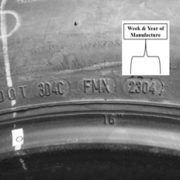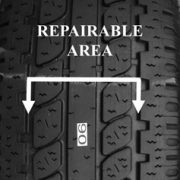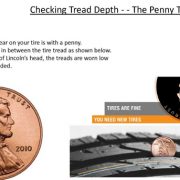



 +1
+1 Before Your Road Trip You Want to Read This!
Robert E. Ammons has been at the forefront of automotive and tire defect litigation for over 25 years representing clients nationwide. He is Board Certified in Personal Injury Trial Law by The Texas Board of Legal Specialization and Board Certified in Civil Law by the National Board of Trial Advocacy. Rob earned his J.D. cum laude in 1988 from Baylor University School of Law. Rob has successfully prosecuted hundreds of catastrophic injury and wrongful death cases against tire manufacturers, automakers, tire retailers and tire service centers. Rob is the author of Tire Defect Litigation, Lawyers & Judge’s Publishing Co.
If you consider that anyone who has ever purchased a used car bought the used tires that were mounted on that used car’s wheels, then most vehicle owners have purchased used tires at some point in their lives. The Rubber Manufacturers Association estimates that 30 million used tires are sold to motorists each year—about 10 percent of the more than 300 million new tires sold annually in the United States. Consumers buy and use most used tires without incident, but there are still risks involved in buying used tires, and they include more than just low tread. But let’s start there.
Tread Depth
Many states have tread depth requirements for tires being driven on their roads. So, used tires can be sold legally as long as the tread depth meets the applicable state standard where it is sold. For example, Texas law requires a minimum tread depth of 2/32nds of an inch. You can check this yourself by using the “Penny Test” shown below.
Tire Age
Until the Ford Explorer-Firestone tire controversy, the concept of tire age degradation (called “thermo-oxidative aging” by engineers) in rubber was an open industry secret. Technical papers on chemistry of aging rubber go back at least to the 1920s. In 2000, the relationship between old tires, hot climates and tire-related fatal crashes became a topic of front-page news. Beginning in the 1990s, some automakers began warning in their owner’s manuals that tires older than six years should only be used in an emergency and replaced as soon as possible. Many tire manufacturers now recommend that tires be removed from service after 10 years or that motorists should follow the vehicle manufacturer recommendations if they differ. In 2008, the National Highway Traffic Safety Administration issued its first consumer advisory on tire age. Tire age still attracts media attention. Broadcast stations nationwide periodically air investigative stories about tire retailers selling aged tires as “new.”
Despite the issue’s continued high profile, tire retailers have been slow to adopt storage practices that prevent accelerated tire aging or educate their employees or customers about age recommendations and the dangers associated with aged tires. In the South, Southwest, and coastal areas, exposure to the elements speeds up rubber deterioration. And tires that are inflated and mounted on a wheel age faster than those that are not mounted. This means that full-sized spares, low mileage vehicles, and RVs that sit unused for long periods are particularly vulnerable.
The Tire Identification Number (TIN), also known as the Department of Transportation (DOT) number, is an alpha-numeric code molded into the tire sidewall and shows the week and year the tire was made by looking at its last four digits. While it takes some special knowledge to read the TIN, properly trained tire technicians can easily determine a tire’s age. Further, properly trained technicians will know when a tire is too old to be put into or remain in service.
The last four digits of the tire’s DOT tell you the week and year when the tire was made. In the example below, the tire was manufactured in the 23rd week of 2004 (which would have been in early June of 2004).
Faulty Repairs
When considering the purchase of a used tire, look to see if the tire has been repaired. While all manufacturers agree that tires can be repaired, an improperly repaired tire can be a safety hazard. Improper repairs include patching a tire outside the repairable area, use of non-recommended repair techniques like string plugs, or a repairing puncture that is too large. Many tire manufacturers, such as Bridgestone-Firestone, warn customers: “An improper repair can be unreliable or permit further damage to the tire. The tire may suddenly fail, causing serious personal injury or death.” The consensus among manufacturers, regulators and retailers is that repairs should be confined to the crown (center part) of the tread; the inner liner should be patched; and puncture holes should be plugged to prevent moisture damage. But to be safe, it is wise to simply choose not to buy a tire that has been repaired.
Recalled Tires
While tire recalls are less common than those affecting vehicles, still more than 5 million tires were recalled in the last decade. Making the problem worse is a recall system that doesn’t work and a recall return rate of less than 30 percent. While tire manufacturers notify new tire retailers about recalls, the information often does not get passed along to a used tire seller. A used tire seller may not even know that a tire in its inventory has been recalled. Putting recalled tires into service or failing to advise a consumer to remove a recalled tire during an inspection are two scenarios that have tragic consequences in which a service center may be liable for damages.
There are many examples of deadly crashes caused by recalled tires. In May 2006, Bridgestone Firestone was forced to issue a recall re-notification for Firestone ATX and Wilderness AT spare tires that had been put into service. Despite one of the largest tire recalls in decades, the defective full-sized spares, stored under the vehicle near the exhaust, were often forgotten in the initial drive to replace the four tires on the vehicle that were making contact with the road. Eventually, the defective spares were passed along in used-vehicle sales and or rotated into service—often by service technicians. The tread on the unused spares was deep, but age, plus prolonged heat exposure, caused these tires to catastrophically fail—often, shortly after being mounted on the vehicle. You can check online to determine whether a tire is subject to a recall here: https://www-odi.nhtsa.dot.gov/owners/SearchSafetyIssues?prodType=T
What to Look For
In general, use caution when considering the purchase of any used product. Tires are no exception. An exhaustive discussion of the potential hazards of used tires is beyond the scope of this article, so it is recommended that consumers avoid using or buying any tire with any of these conditions:
- has tread less than 2/32nds;
- has chunking, bumps, knots, or bulges;
- has exposed tire cords or belt material;
- has a repair in the tread shoulder, sidewall, bead area or belt edge area;
- has a puncture that has not been properly sealed or patched on the inside
- 6. does not clearly show the United States Department of Transportation Tire Identification Number on the sidewall;
- is subject to a manufacturer’s safety recall; or
- has a puncture larger than ¼ inch.
Parting Words
Used tires can come from many sources, such as tire service centers, eBay, salvage yards, web classifieds, and even car dealerships selling used or certified vehicles. Some used tires are undoubtedly safe and sold for a price that is a relative bargain. But other used tires may have a variety of hazards that are not readily apparent to the average consumer. They may be aged, improperly repaired or stored, recalled—or any combination of these. Take care to consider the things described in this article when deciding whether to purchase used tires.




























